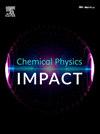Enhancing the photocatalytic properties of nickel oxide nanoparticles via iron doping: Efficient degradation of eosin yellow dye
IF 3.8
Q2 CHEMISTRY, PHYSICAL
引用次数: 0
Abstract
In this study, iron (Fe) doping was employed to enhance the photocatalytic performance of Nickel Oxide Nanoparticles (NiONPs), particularly in the degradation of Eosin Yellow, a representative organic dye. NiONPs were synthesized via a chemical precipitation method using nickel nitrate hexahydrate as the precursor, with iron (III) nitrate nonahydrate introduced as the dopant to achieve Fe concentrations of 2 %, 4 %, 6 %, and 8 % in the NiONPs. The resulting Fe-doped NiONPs were characterized using Fourier transform infrared spectroscopy (FT-IR), X-ray diffraction (XRD), scanning electron microscopy (SEM), and energy-dispersive X-ray spectroscopy (EDX). The photocatalytic performance was evaluated by monitoring the degradation of Eosin Yellow under visible light irradiation. The characterization studies confirmed successful Fe doping in the NiO lattice, resulting in structural and compositional changes. Photocatalytic testing revealed that Fe doping enhanced the degradation efficiency of NiONPs for Eosin Yellow. Among the tested samples, 4 % Fe-doped NiONPs showed an impressive increase of nearly 30 % in degradation efficiency compared to undoped NiONPs. This enhancement is attributed to improved charge separation and increased light absorption, driven by the Fe dopant's influence on the electronic structure of NiONPs. The improved photocatalytic performance of Fe-doped NiONPs can be explained by the reduction of electron-hole recombination, which enhances the generation of reactive species responsible for dye degradation. These findings highlight the potential of Fe-doped NiONPs for applications in environmental remediation, especially in wastewater treatment processes aimed at removing organic pollutants.

铁掺杂增强氧化镍纳米颗粒的光催化性能:对伊红黄染料的高效降解
在这项研究中,采用铁(Fe)掺杂来提高氧化镍纳米颗粒(NiONPs)的光催化性能,特别是在降解具有代表性的有机染料伊红黄方面。以六水硝酸镍为前驱体,引入非水合硝酸铁(III)为掺杂剂,采用化学沉淀法合成NiONPs,得到了铁浓度分别为2%、4%、6%和8%的NiONPs。利用傅里叶变换红外光谱(FT-IR)、x射线衍射(XRD)、扫描电镜(SEM)和能量色散x射线能谱(EDX)对fe掺杂的NiONPs进行了表征。通过监测可见光下对曙红黄的降解情况,评价其光催化性能。表征研究证实了Fe在NiO晶格中成功掺杂,导致了结构和成分的变化。光催化实验表明,Fe掺杂提高了NiONPs对伊红黄的降解效率。在测试样品中,4% fe掺杂的NiONPs与未掺杂的NiONPs相比,降解效率提高了近30%。这种增强是由于Fe掺杂剂对NiONPs电子结构的影响,改善了电荷分离和光吸收。fe掺杂的NiONPs光催化性能的提高可以通过减少电子-空穴复合来解释,这增加了负责染料降解的活性物质的产生。这些发现突出了铁掺杂NiONPs在环境修复中的应用潜力,特别是在旨在去除有机污染物的废水处理过程中。
本文章由计算机程序翻译,如有差异,请以英文原文为准。
求助全文
约1分钟内获得全文
求助全文
来源期刊

Chemical Physics Impact
Materials Science-Materials Science (miscellaneous)
CiteScore
2.60
自引率
0.00%
发文量
65
审稿时长
46 days
 求助内容:
求助内容: 应助结果提醒方式:
应助结果提醒方式:


